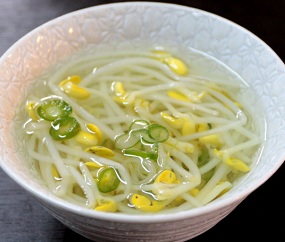របៀបបណ្តុះសណ្តែកកូរ៉េ (How to grow Soybean Sprouts_Kongnamul: 콩나물)

Soybean sprouts (kongnamul)
are one of the most commonly used ingredients in Korean cuisine. I
think almost every Korean family makes cooked and seasoned soybean sprouts (kongnamulmuchim), and soybean sprout soup (kongnamulguk) at least once a week. It’s that popular.
You can sprout your own kongnamul at home, and they are tastier and nuttier than the ones you buy in the store.
1 cup of dried soybeans will make 1½ pounds of sprouts. When the beans
are sprouted, more vitamins and minerals are created, making them even
more healthy than the original beans. And homegrown kongnamul have wonderful, long roots, unlike kongnamul sold in grocery stores.
You
can use the whole sprouts in your cooking or snip the roots off with
fingers. But don’t throw them away: you can make another beautiful side
dish with them. Some Koreans think that the roots have more vitamins and
minerals than the stems. Soybeans used for sprouting (called kongnamul kong
in Korean) are smaller than usual soybeans, so be sure to choose the
right one! Regular soybeans won’t sprout easily; they’re used to make
things like doenjang (fermented soybean paste), tofu, and soy milk.
Early one morning, when I was in elementary school visiting my grandmother, I saw how she sprouted her soybeans. She kept her kongnamul in
the room where she slept, behind her head, so she could always look
after it. Traditional Korean heating systems have heated floors, so the
floor is always the warmest. I saw her pulling back a black cloth from
an earthenware bowl on top of a basin, and then using a gourd to scoop
water from the basin to the bowl.
Traditionally Koreans used to
sprout the beans in an earthenware bowl with holes in the bottom for the
water to drain out, called a siru. This was kept above a basin
of water with 2 wooden sticks, and my grandmother would use a gourd to
bring the water from the basin back over the sprouts. Then a black cloth
was put over top to keep it all dark.
I remember the finished product was a huge amount of kongnamul, grown very crowded together. The color of the beans were a beautiful yellow.
I found growing kongnamul is very easy: all you need are soybeans for sprouting, water, and a little effort! I place my kongnamul
planter right next to my kitchen sink, so I can water it as many times
as possible. It’s really fun watching these beans grow and seeing the
large quantity of kongnamul sprout from such small amount beans.
Ingredients:
- 1 cup of soybeans for sprouting (6½ ounces: 180 grams)
- water
Directions:
- Rinse the soybeans in cold water and soak for 24 hours.


- Pick out dead beans or broken beans and put the cleaned soybeans into a planter that has small holes in the bottom.

- Pour water over the planter, little by little, till the beans are wet evenly. The water will drop out the holes in the bottom but the beans will be wet.
- Cover the planter with a black cloth to keep the
light out. If too much light gets in, the beans will turn green instead
of a nice yellow color.

- Repeat watering every 3 or 4 hours for 4 to 6 days until the beans grow about 4 inches.

- Rinse the sprouts a couple of times and drain. Drain and store them in the refrigerator.
 |
គង់ណាមុលគុក ( Kong-na-mul- guk):

Kongnamulguk is a refreshing Korean soup primarily based on soybean sprouts, some minced garlic and scallions which is cheap and easy to make. It is considered to be light and healthy, containing full of vitamin C and low in calorie content. Very much similar to bookuhguk, this soup can be a great ailment for hangovers as well as colds. For spicy food lovers, splash of red pepper flakes (gochugaru) can be added to add some kick to the flavor.
| Recipe Ingredients |
|
| Cooking Directions |
- Thoroughly wash soybean sprouts and drain water thereafter. Remove any bad parts and trim roots, if desired.
- In a pot, sauté garlic in soy sauce and sesame oil over medium heat for 2-3 minutes.
- Add water, salt, soyean sprouts and bring to a boil over high heat.
- Reduce to low heat and simmer for 15-20 minutes. Make sure to cover pot and try not to remove lid as the flavor will spoil.
- For spicy version, add gochugaru 5 minutes before turning off the heat.
- Chop and garnish with scallion before serving.


No comments:
Post a Comment